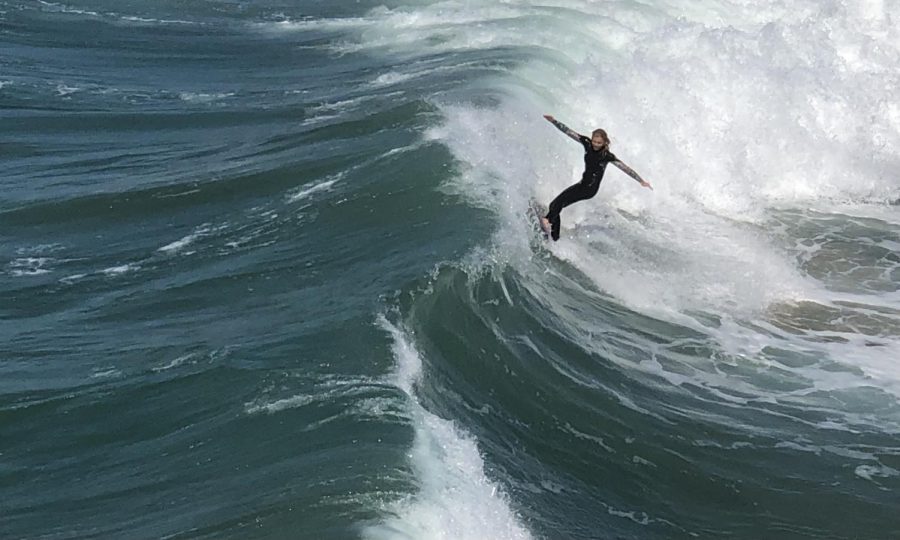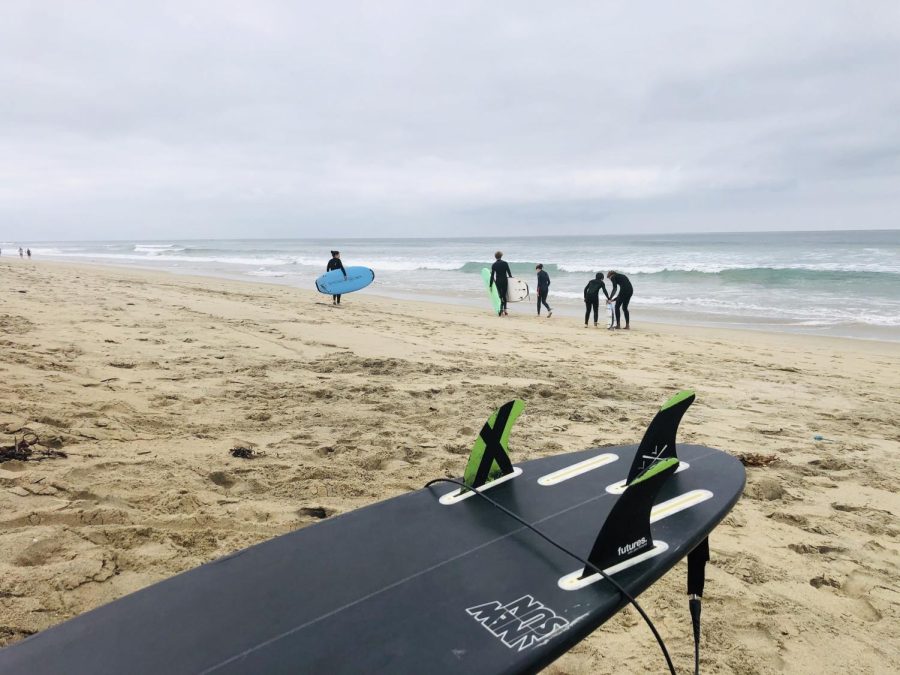Bill Shrader feels the wave building behind him, staying concentrated on the shoreline ahead. The wave’s growing momentum pushes him faster and faster as he paddles through the cold water, pushing his body up, he catches the wave just as it begins to break.
“As you line up to catch the surf, you feel the waves underneath you, and it’s almost like a forced meditation. As the waves are coming, you are transitioning into a relaxed and present state,” Shrader said.
Shrader found a community on the beaches of Northern California, the shared experience of waiting to catch a wave creating a connection between the surfers. Swimming had just been a sport to Shrader, but surfing became a passion of his.
“Surfing is something very personal, but you also have a community. There are all walks of life in the waves. From 70 to 7 years old, everybody is surfing together,” Shrader said.
For another surfer, Roz Sarah, surfing goes beyond a sport. It is her life, giving her a way to free her mind from life’s daily struggles and helping her heal mentally.
“Surfing has taught me so many things about myself. So many things you apply to surf, apply to life: patience, gratitude, conquering fears. If you can face huge waves, it changes your attitude. There are a lot of mental health benefits too. I lost my younger sister, so surfing has become my therapy,” Sarah said.
Sarah isn’t alone in finding surfing therapeutic. The International Surf Therapy Organization hopes to bring surfing to more people as a way of coping, and there have been many programs set up along coastlines.
Though there is limited research, an article published by The Global Journal of Community Psychology Practice highlights seven studies focused on the effects of surf therapy on children and young adults. The participants in one study had increased self-concept, emotional regulation, and socialization. Participants were more engaged in school and had fewer behavioral problems. Another study showed that 98% of participants reported feeling significantly happier after surf therapy.
Sarah has witnessed these benefits first-hand. When she surfs, everything else fades away. It’s just her, the waves, and the sand.
“For me, the most important thing in life is surfing. The rest — news, gossip — doesn’t matter in the waves,” Sarah said.
Huntington Beach, where Sarah surfs, is known as Surf City. It is also the location of the Clint Carroll Surf School. The school’s lessons are based on the fundamentals shaped by the world champion surfer, Corky Carroll. Carroll pioneered surfing in California and became the first actual professional surfer. Clint Carroll, his son, runs the surf school and is out in the water almost every day.
“There’s a lot of pressure on us these days. When you get down to the beach, it’s such a release. Once your feet touch the sand as you’re walking toward the water, you instantly start losing the stress,” Carroll said.
However, surfers recognize that the ocean they love so dearly, is facing serious environmental threats. Since surfers spend so much time in the water, they are inclined to protect the ocean from the damages of climate change.
“Our oceans are getting more and more polluted, and as surfers, we are dealing with that more these days. There are groups and organizations, like the Surfrider Foundation, that focus on dealing with environmental issues,” Carroll said.
An increasing environmental consciousness has arisen amongst surfers. In 1984, a group of surfers became aware of the issues that impacted beaches and coastal habitats. So, they founded the Surfrider Foundation. Today, the foundation fights to protect the ocean and coastline while reducing the impact of pollution on aquatic ecosystems.
“Surfers are active participants in the environment, being out in the water every day. Surfers in our foundation, like me, fight to keep beaches protected so surfers, and the public, can enjoy surfing the waves,” said Eddie Anaya, the director of communications at the Surfrider Foundation.
Wastes, like plastic bags and fishing nets, are dangerous for both aquatic animals and surfers. This pollution is usually easily spotted. But often, liquid waste can go unseen from the shoreline. It isn’t until surfers go out in the water that problems like oil spills are discovered.
“Surfers are on the frontlines. They’re the ones that are in the water on a consistent basis, so they see things more easily. When there was an oil spill in Huntington Beach a few months back, surfers were some of the first people to notice. Runoff from urban areas, sewage, fertilizer, animal waste, and oil can get pushed out into the water. This happens especially when it rains. Typically you’re advised not to go into the water for 72 hours after it rains so that all the pollution gets dissipated,” Anaya said.
Global warming has caused sea levels to rise, directly affecting beaches. The rising water changes the coastal landscapes, and surfers witness these problems up close. Anaya has observed this sea-level rise. According to the San Mateo County Office of Sustainability, the sea level in Half Moon Bay is predicted to rise 0.8 feet by 2030. This rise could flood beaches and erode cliffsides, making surfing next to impossible.
“Because of sea-level rise, water is getting higher and higher, decade after decade. Some of the beaches that I grew up surfing don’t have much beach left. People that live close to the beach end up putting coastal armoring on the cliffs, which changes the whole topography of the beaches,” Anaya said.
As a surfer, Anaya directly sees how the environment is changing. He notices that surfers are becoming more educated about environmental issues because they’ve seen them up close.
“Surfers are the ones who are raising the red flag. That helps local, state, and federal policymakers get real-world feedback and let them know what’s going on and what they should be fighting for,” Anaya said.
These policymakers enacted the Clean Water Act, which regulates the pollutants discharged into water. It ensures that water remains safe not only for human health but also for aquatic ecosystems.
Surfers know it is crucial to raise awareness about environmental issues and continue to care for beaches. Carroll wants to make sure surfing, one of the things he loves most, remains protected for years to come.
“When you’re out in the waves, and a dolphin swims by, you know you are back in nature. Surfing is not just a sport. It’s a lifestyle,” Carroll said.























